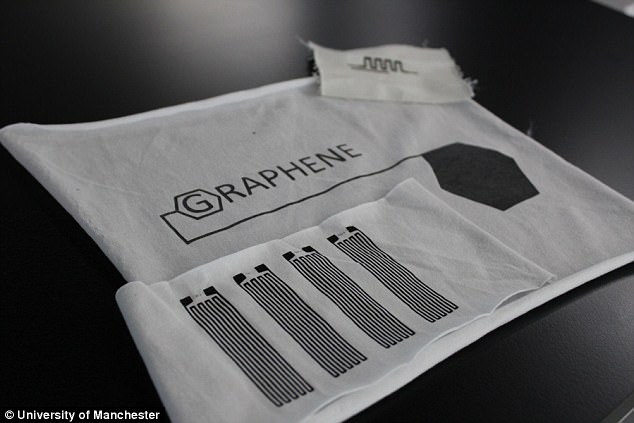Caption: In an effort to eliminate the need for cumbersome battery packs that limit the shape and size of wearables, researchers have created flexible battery-like devices that can be printed directly onto textiles such as cotton / source: University of Manchester via: DailyMail
-
Researchers invented a flexible battery-like device that can power wearables
-
It can be screen-printed right onto cotton to make your clothes smart wearables
-
It could be used for workout gear, military clothing, or 'wearable computers'
Researchers have created technology that overcomes one of the biggest hurdles related to wearables – how to power them.
In an effort to eliminate the need for cumbersome battery packs that limit the shape and size of wearables, researchers have created flexible battery-like devices that can be printed directly onto textiles.
Using a simple screen-printing technique, they have been able to make cotton into a wearable itself.
WHAT CAN BE MADE WITH IT?
The device's flexibility and ability to be printed on cotton give it potential for practically limitless applications.
The researchers proposed the following uses:
– High-performance sportswear that monitors performance
-Embedded health-monitoring device
Lightweight military gear
-New classes of mobile communication devices
-Wearable computers
'It will open up possibilities of making an environmental friendly and cost-effective smart e-textile that can store energy and monitor human activity and physiological condition at the same time,' said Nazmul Karim, Knowledge Exchange Fellow at The University of Manchester, who co-authored the paper.
Devices known as supercapacitors that are lightweight and can allow for rapid charging have been seen as the key, and now this new development of a solid-state supercapacitor that is also flexible demonstrates it can be printed on fabric.
These printed electrodes have shown 'excellent' mechanical stability due to the strong interaction between the ink and textile.
'The development of graphene-based flexible textile supercapacitor using a simple and scalable printing technique is a significant step towards realizing multifunctional next generation wearable e-textiles,' Karim said.
With more development, these supercapacitors could turn the increase the potential of wearables drastically.
A low cost is also necessary, which makes the success with graphene-oxide, a form of graphene, a big win – it can be produced and applied to textiles relatively cheaply and easily
Applications could include: high-performance sportswear that monitors performance, embedded health-monitoring devices, lightweight military gear and new classes of mobile communication devices.
The researchers say even 'wearable computers' can't be ruled out.
'The device is also washable, which makes it practically possible to use it for the future smart clothes,' said Amor Abdelkader, the study's other author.
'We believe this work will open the door for printing other types of devices on textile using 2D-materials inks.'
Reasonable mechanical flexibility is necessary to powering new types of devices being conceived, as is high energy and power density, good operational safety, and long cycling life.
'Textiles are some of the most flexible substrates, and for the first time, we printed a stable device that can store energy and be as flexible as cotton,' Abdelkader said.
A low cost is also necessary, which makes the success with graphene-oxide, a form of graphene, a big win – it can be produced and applied to textiles relatively cheaply and easily.
The University of Manchester is currently building its second major graphene facility, which is plants to complete in 2018 for £60m.
It will complement the National Graphene Institute (NGI) as an international research and technology facility.
The wearable industry is continuing a steady climb with multiple major tech tech firms continuing to push the products.
Sales of wearables rose 21 percent to 22 million units over the last year, according to a report from Strategy Analytics.
With this flexible battery-like device that can be printed on textiles, you could 'connect' your entire outfit with smart technology
